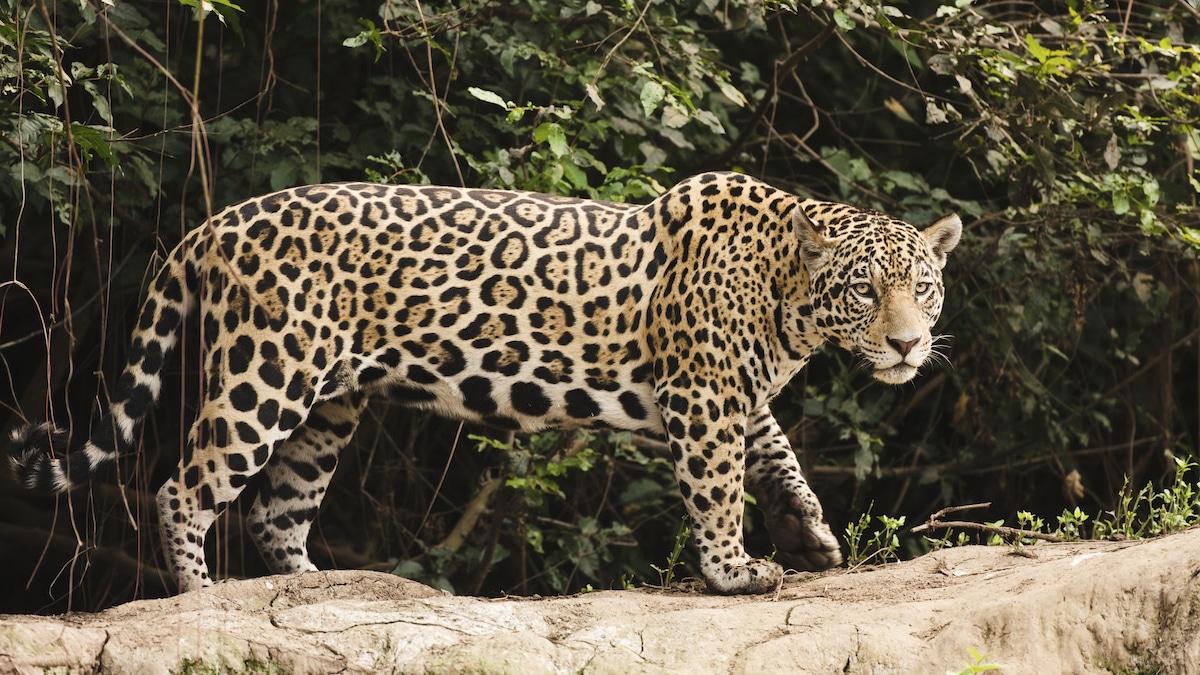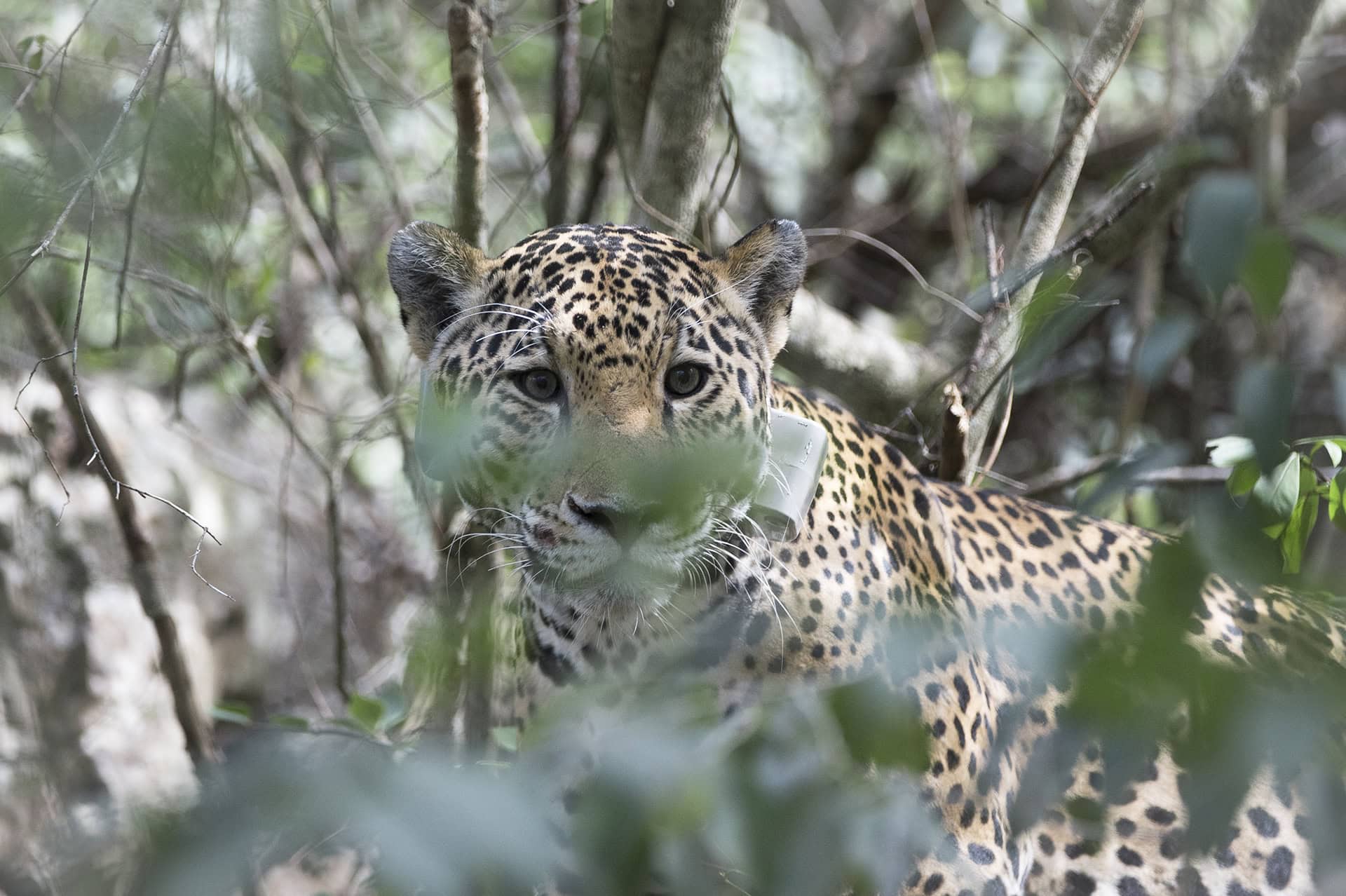The lowland forest of El Impenetrable National Park in northern Argentina sprawls across the hot, swampy green of the Gran Chaco biome, home to South America’s largest mammals and thousands of plant species. It’s a critical conservation unit for the protection of one of the planet’s most deforested ecosystems, yet it’s missing an important resident: a female jaguar (Panthera onca).
Two-thirds of the Gran Chaco, which spreads across 650,000 square kilometers (251,000 square miles), are in northern Argentina, where just 10 jaguars remain — all of them male. The last female was spotted there 35 years ago, Sebastián Di Martino, conservation director at the NGO Rewilding Argentina, told Mongabay. “The situation here is urgent,” he said. “The males look for females, but never find one.”

Keraná, a female rescued as a cub in Paraguay, is the new beacon of hope for the Argentinian Chaco’s jaguars. On March 15, she was released into El Impenetrable in a joint effort between Rewilding Argentina, the National Parks Administration, and the government of Chaco province. She will soon be joined by a second female, Nalá, in the next few weeks. Rewilding experts say they hope these females will breed with the wild males and help bring the population back from the brink of a regional extinction.
The release came after years of careful planning, which began in September 2019 when footprints and camera traps confirmed the first male jaguar in El Impenetrable. Rewilding experts set up an enclosure in the region for a captive female from the Jaguar Reproduction and Reintroduction Center at Iberá Park in Corrientes province, in the hope she would mate with the male. It worked, and in 2021, the female had cubs within a 2-hectare (5-acre) pen with no human contact to ensure the cubs could be reintroduced into the wild in the future; Nalá, who will be released soon, is one of those cubs.
“Since there are no wild females, it’s impossible [to create a viable population] if we don’t do this,” Di Martino said.

The situation of the solitary male jaguars in Argentina’s Gran Chaco reflects the overall loss of their species across the country. Today, there are around 173,000 jaguars left in the world, mostly found in the Amazon Rainforest and the Brazilian Pantanal, the world’s largest tropical wetland. Yet in Argentina, jaguars have lost more than 95% of their original range, whittling their numbers down to fewer than 250 surviving in fragmented populations or alone.
“Jaguars have been heavily hunted in the Chaco region, first for their skins and then for livestock conflict. In the last 15 years, there has been intense habitat loss in the Chaco to plant soybeans,” Gerardo Cerón, a biologist and conservation coordinator at the El Impenetrable project, told Mongabay.

The Chaco fans out from northern Argentina into Paraguay (accounting for 23% of the biome), Bolivia (13%) and Brazil (4%). In South America, it’s second only to the Amazon Rainforest in terms of ecological importance and size, yet it’s one of the most threatened ecosystems in the world. In Argentina alone, the Gran Chaco has lost more than 8 million hectares (20 million acres) in the past three decades to clear space for soy farms and cattle ranches.
The jaguar’s return is an important milestone in the protection of this biome. “Its presence increases the health and biodiversity of the ecosystem, so it is key that they are there for the functionality of the entire El Impenetrable and Gran Chaco region,” Cerón said.
Getting the community on board
The jaguars’ return is also expected to attract more visitors to the park and help boost the region’s economy.
“We’re working to build an economy based on nature tourism and wildlife watching,” Di Martino said. “When you change the economy from cattle ranching to nature tourism, species like jaguars transform from being a problem to being an opportunity associated with jobs and regional development. It’s a way to build social and political support.”

To build community support, Rewilding Argentina has been working with almost 600 families in the park’s proximity to upskill them to receive tourists. The community-focused project ranges from school visits aimed at teaching children about wildlife, to training locals as tour guides who can offer experiences such as camping, horse riding, canoeing and wildlife watching.
“Involving local communities is essential for this type of project to be successful, since they are going to be the guardians of the jaguars and any other species in the region,” Marisi López, the parks and communities coordinator at Rewilding Argentina, told Mongabay.
Reintroducing jaguars elsewhere in Argentina has proved successful, such as in nearby Corrientes province, where efforts have been made to restore the Iberá wetlands. Now home to 21 jaguars thanks to rewilding efforts, nature-based tourism in Iberá has become central to the local economy.
A similar case can be found in Brazil’s Pantanal, where ranchers once considered jaguars as pests due to livestock conflicts, yet now see them as a source of income, largely thanks to carefully orchestrated efforts by NGOs such as the Jaguar Identification Project. A 2017 study shines a light on how important jaguar tourism is in the Pantanal: jaguar watching generated $6.8 million in gross annual income in the northern Pantanal, against $121,500 in losses from cattle depredation. In other words, jaguars in Brazil’s Pantanal are worth up to 56 times more in tourism than the costs they inflict on ranchers.
Creating jaguar corridors
In the northeast Iguazú region in Argentina there are currently between 80 and 100 jaguars, and about 120 individuals in the northwestern provinces of Salta and Jujuy. The two populations are separated by about 1,400 km (870 mi). “It’s impossible for a jaguar to walk that distance to reach the other population,” Di Martino said. “Our strategy is to build new breeding areas between them.”

Creating ecological corridors is a crucial step to join the patchwork of jaguar populations across northern Argentina, benefiting not only big cats but other species too, such as giant otters (Pteronura brasiliensis), marsh deer (Blastocerus dichotomus) and anteaters (Myrmecophaga tridactyla). Bit by bit, the distance between these two groups is being reduced thanks to the growing number of jaguars in Iberá’s wetlands and now the hopeful new population in El Impenetrable. “We’ve started to have stepping stones between the two breeding populations on either side of Argentina,” Di Martino said.
Rewilding experts say they hope that future reintroduction efforts in other national and provincial parks will string all these jaguar populations in the north together. The ecological corridor will inject much-needed genetic diversity into the jaguar population while also building an ecotourism-based economy for local communities.
“It’s a vision in which progress and the recovery of nature go hand in hand,” Cerón said. “But what is needed now in this first stage, of course, is a lot of breeding and to increase jaguar numbers.”
Citation:
Tortato, F. R., Izzo, T. J., Hoogesteijn, R., & Peres, C. A. (2017). The numbers of the beast: Valuation of jaguar (Panthera onca) tourism and cattle depredation in the Brazilian Pantanal. Global Ecology and Conservation, 11, 106-114. doi:10.1016/j.gecco.2017.05.00 3
This article by Sarah Brown was first published by Mongabay.com on 27 March 2024. Lead Image: Nalá as a cub, who was born in 2021 from a captive female and a wild male. Now an adult, she will be the second female jaguar to be released into the El Impenetrable National Park in northern Argentina to revive the species. Image © Gerardo Cerón / Rewilding Argentina.
What you can do
Help to save wildlife by donating as little as $1 – It only takes a minute.







Leave a Reply